Slightly over three years ago, I acquired my first 3D printer, a UP! Mini. I didn’t know it at the time but as a beginning printer it was perfect for me. Two years later I was familiar with the weaknesses of my printer and wanted more. I studied reviews, I put various printers on my Amazon wish list but never actually committed myself to one.
I fell in love when Prusa 3D introduced their i3 MK2. My fate was sealed when Make magazine rated it number one in their annual review of 3D printers. About a week later I placed my order, just in time to enter a queue of all the other people that read the same review. I bought the kit because I had great confidence in my ability and I wanted to save money. Call it a case of penny-pinching and overconfidence.
Six weeks later, I received a very complete kit. No problems putting it together but getting it to print was another story. Everything pointed to problems setting the PINDA sensor. I found a tool on Thingiverse that makes adjusting the position trivial. It helped but not enough. When I found out I was setting the live Z adjust way too small everything came together. For the next two weeks everything was great and then disaster struck.
Somehow, in the middle of a print and deep in the night, my PINDA sensor broke off and got raked over my extruder nozzle. Melted insulation all over the place.
Prusa has since improved their design to make setting the PINDA easier and based on the stress fractures I saw in my broken PINDA mounting, I was partly to blame for the failure. Still, I needed a new PINDA.
Prusa will sell you a new PINDA and at a very reasonable price, about $10 but it’s not listed. You have to ask one of their sales agents and then you have to pay postage, lots of postage, $60 in my case.
I don’t like paying $60 postage for a $10 part. I certainly don’t like the fact that my open source printer is not quite open source. Searching the Internet for information, I found very little telling me exactly what the Prusa sensor was. Cutting the remains of my sensor off the printer, I started making measurements. Here;s what I found.
- 8 mm in diameter, 37 mm long
- 2 mm sensor
- 5 volt operation
- Normally Closed (NC) operation
- NPN
After searching a number of vendors, I had to admit that Prusa seems to have the market cornered. At 37 mm, they are the shortest in the market. I was able to find a 42 mm sensor, an E2B-S08KN02-WP-C2 2M by OMRON. This sensor would fit but it operated at 10 to 30 volts and was out of stock at Digikey and Mouser.
Looking at Amazon, my favorite shopping spot, almost all of the proximity sensors available are 6 to 36 volts and approximately 70 mm long. While the sensors will fit in the Prusa PINDA mount, the odds are they won’t operate at 5 volts. It’s close enough that some of them might but you can’t depend on it and reported results very.
I felt like I was at a dead end until I found the Pololu 12V step-up voltage regulator. The Pololu U3V13F12 ($3.95 at Pololu) is a tiny voltage converter. Put in 5V and 12V comes out. Perfect for the sensor and small enough to place in line with the cable but what about the Prusa controller?
I don’t believe it’s by design but the NPN structure of the sensor makes using this voltage converter easy. Because the sensor’s output is open collector, I can use the step-up regulator to operate the sensor at 12V and the output to the Prusa is exactly as if the sensor were operating at 5V. See the diagram below.
I used an LJ8A3-2-Z/AX ($8.62 from Amazon) with the U3V13F12 for my experiments.
Did it work? Yes and no. All indications are that my PINDA is working. I have excellent adhesion to the platform but now my filament feed is giving me problems. I may have deformed my Teflon tubing feed. Sigh, another tear down this weekend.
One last note. If you look in the literature on the OMIRON sensor, it’s rated for 70 degrees C. My print bed is usually set at 100 degrees for ABS. I don’t know what the Prusa PINDA is rated at but this could explain why so many people notice a difference when the sensor is near the print bed before it starts measurements. Just a thought.
PS: The MK3S eliminated a number of problems with the PINDA but introduced a totally different failure mechanism. If you own a MK3S make sure you read Prusa MK3S, Built in Self Destruct or Swiss Cheese Theory of Failure before it happens to you.
© 2017 – 2020, Byron Seastrunk. All rights reserved.

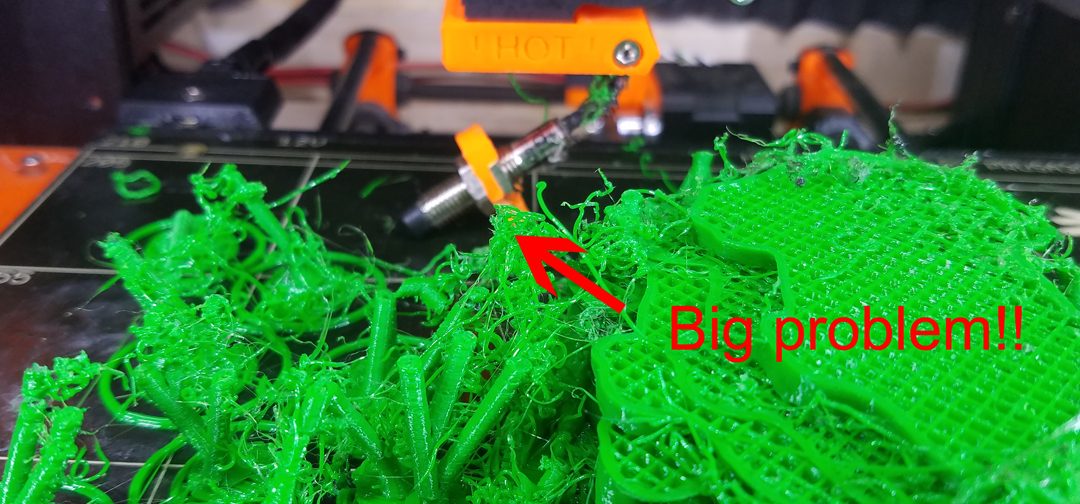


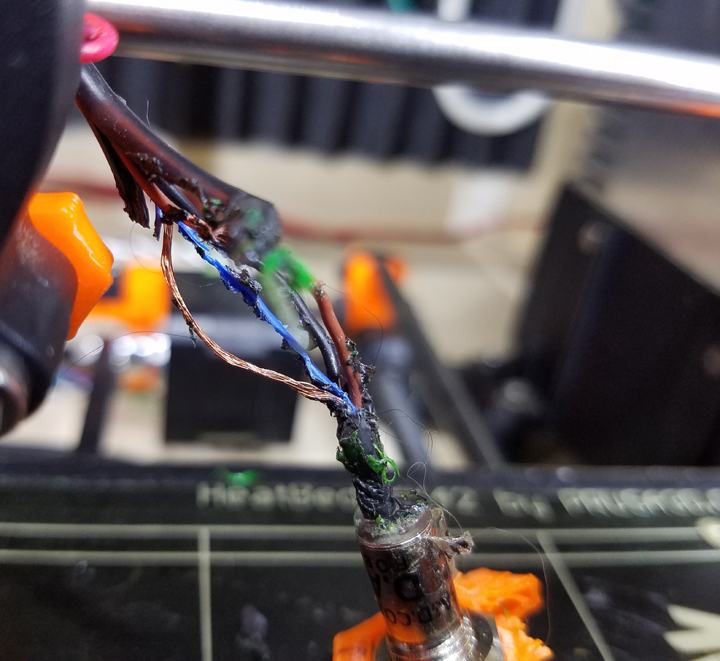
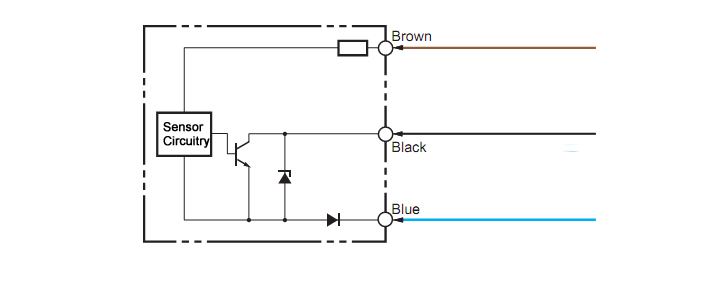
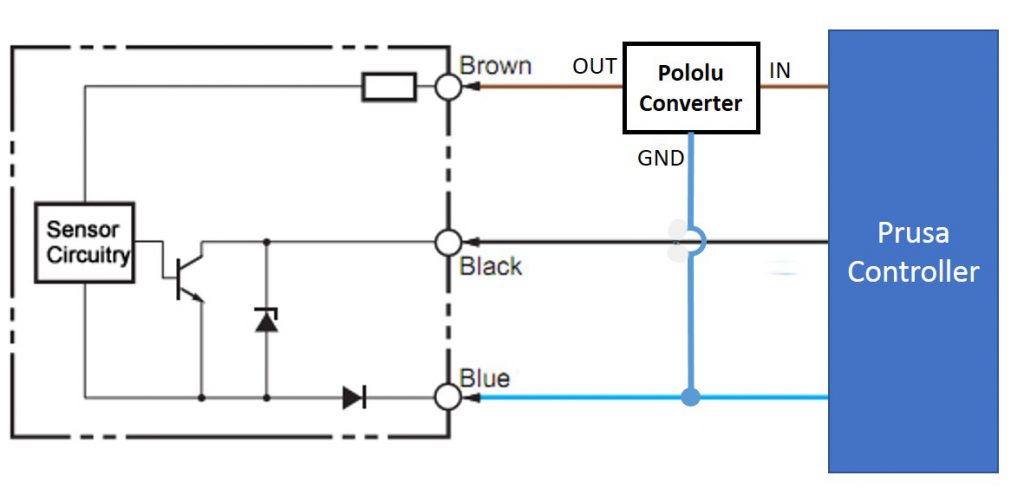
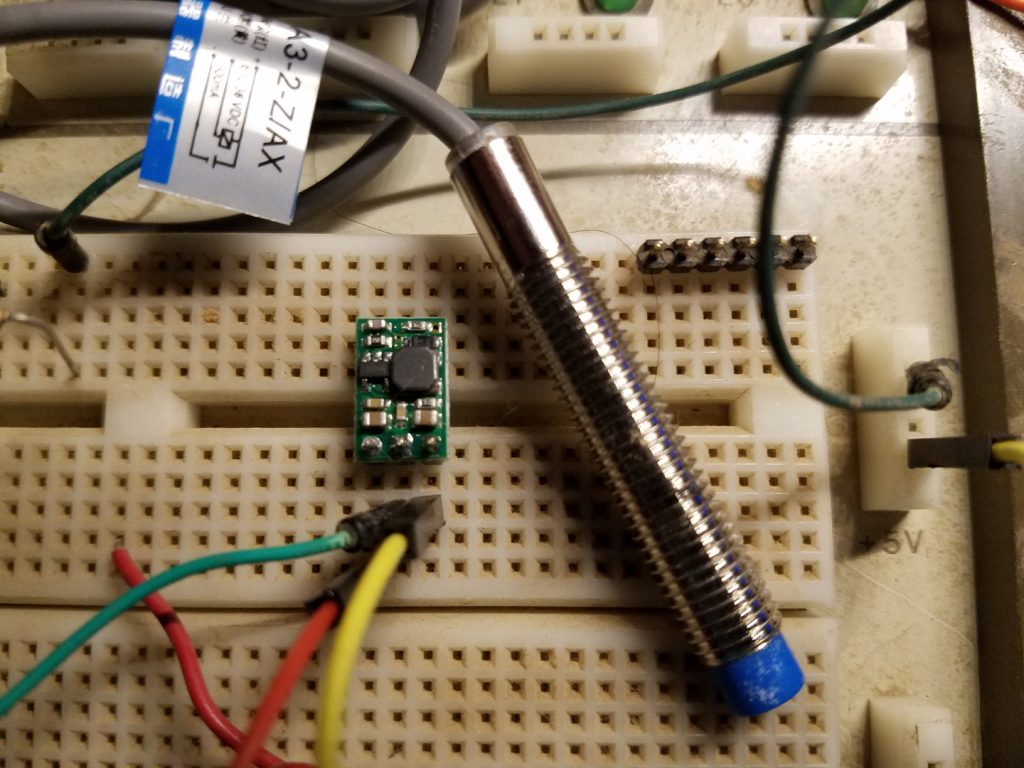









Byron, did you find a pinda replacement close to Prusa specifications? I was not using the printer and my 4 mm is giving me problems
I have to admit I abandoned my MK2 in favor of a MK3S. I’m very glad I did but it has its own PINDA problems. I’m about to replace the PINDA support for second time. Over time it starts to droop and finally break. To be fair that’s probably because I print a lot of ASA and ABS.
I’m not sure I follow the thrust of the problem with using a 4mm sense distance probe here. You set your probe 2mm higher in the mount and achieve the exact same result in terms of senseing, only superior because you now no longer have your probe face right down by the nozzle and print with potential for collision with some errant piece of plastic. The reason the original is only a 2mm sensing distance is not due to some inherent advantage with being that close, just the opposite. The reason is that practically all probes in that small 8mm form factor have a tiny sense coil and so have to be only 2mm away to work. these 4mm sense 8mm probes have deeper/larger coils and so provide superior performance, 2mm more detection range.
The logic is sound but accuracy and precision of the probe are usually defined as a function of the probe’s range. Your Z adjust takes care of the accuracy part but since precision is also based on range the 2mm probe is usually twice as precise as the 4mm probe. This can make a big difference in bed leveling.
Whilst that is “technically” accurate, given two sensors from the same manufacturer using identical diameter and height coils with identical backend precision in the amplifier etc, the reality is functionally and practically that’s a non-issue as the accuracy and repeatability of either is far more than adequate given the relative imprecision and repeatability of the mechanical system of even a high-end 3d printer using precision linear rails and ground ballscrews, let alone a Prusa. Now i’m sure it is possible to find a sensor so inferior as that this would become a consideration but you’d have to be trying quite hard.
This can be confirmed by examination of the comparative datasheets and a few minutes calculating your axis maximum accuracy. EG
https://blog.prusaprinters.org/calculator/
You can see this expanded upon here in this myth-busting video.
https://youtu.be/il9bNWn66BY?t=559
You certainly live in a different world than I do when you talk about identical probes. The inability to produce identical probes is the reason we have accuracy and precision issues in the first place. Still, as I said, accuracy is a moot point as the Z adjust takes care of that. I only care how repeatable the measurements made by my probe are for the nine calibration points used to determine a level bed. Given that an adjustment of 0.050 mm on my live Z makes all the difference on that first layer sticking, I would want the repeatability error on my probe to be on the order of .025 or less. I’ll stick with my 2 mm probe.
Do these third party pinda replacement probes have the thermistor, for temperature compensation? If not, this is a big disadvantage.
Would it be sensible to make a small (thin) silicone sock to put over the bottom on the inductive sensor, to insulate it from heat coming from the bed?
I don’t know about the third party vendors. As far as I know, the MK2 PINDA does not have thermal compensation. That was one of the driving issues for me to upgrade to the MK3. The silicone sock is an interesting question. I’ve certainly never tried it. I do remember seeing a design on Thingiverse that was supposed to protect the tip of your PINDA while still leaving it functional. You might see if it’s still listed.
You’re correct that the MK2 doesn’t have thermal compensation.
I’m not even sure it would need to be silicone, any plastic would probably be insulating enough.
I am currently using an 18mm diameter probe (8mm sensing distance). Repeatability is ok, but it gets thrown off by temperature effects. I had initially thought that having a longer distance probe, and therefore having it further from the heat source, would help. According to a video by Tom3D the longer distance probes are affected more by temperature than the shorter ones: https://youtu.be/il9bNWn66BY
It may be that the 18mm diameter probe having such a large surface near the heat source just “collects” more heat, and as the sensor is bigger it takes longer to cool down (assuming it’s actually heavier than the 8mm diameter probes).
Another puzzling thing in Tom’s video above is that at the end he claims the repeatability of the 4mm sensing distance probe is higher than the 2mm sensing distance probe. I’m not sure why that would be.
I can see why the longer distance probes are more affected by heat, The temperature coefficient is probably a percent of full scale. If you assume similar effects between the two, the total error would be greater for the longer distance probe. I have to admit I have no idea why the repeatability of the 4 mm probe is better than the 2 mm probe. One of the techniques I ran across during my own troubles was to park the extruder well above the bed when the print was finished. This meant that the probe was well away from the bed when it started heating. I did notice an improvement but can’t say how much.
Hello Byron!
Thanks for your article. I got the same probe as a 5V version from AliExpress. It does work fine at 5V and the detection distance isn’t any greater if I give it 12V, so it’s not just advertised at a different voltage, instead it’s really made for it. My issue is, that even above the Prusa MK42 heatbed’s leveling points the detection distance is really, really low. Like 0.3mm low (3 sheets of paper). That makes it very difficult to set it up in a way that it won’t interfere with the top printed layer of a model while still not driving the nozzle into the heatbed when leveling or printing the first layer.
Is it possible that the probe itself is “broken” in a way that still makes it work but just with a shorter distance?
Thank you in advance!
Dave
Hi Dave,
Thanks for your persistance in trying to reply. You managed to post three replies but since this was your first response, I had to approve it before you see it. It’s a pain but it cuts down on the spammers.
The answer to your question is yes, very possible. However, and I apoligize for the length of my answer, not all probes are created equal. You have five basic types, capacitive, inductive, magnetic, optical and contact. I believe the Prusa is inductive and the leveling points are steel to give a good reading. If you’re using tape, glass or extra thick PEI, you’re still sensing the distance from the leveling point to the probe. If for some reason you’ve modified the probe mount with a lot of metal, the sensing distance will appear to be shorter. You can think of an inductive probe as a metal detector.
It does sound like you have a bad sensor but you may also have contributing factors.
My experience with same sensor from AllExpress, my first sensor, was exactly the same. I order a replacement and still really low detection distance. just sharing my experience per what you had with same sensor. I almost sure is same)
I found how to get these PINDA V2 probes. The new gray kind (just recently received with my MK3). 5v, the tag matches the tag that was on the PINDA that OP received. Here is the spec sheet:
M8 Shorter Inductive Proximity Sensor with Cable
Size M8 * 35mm
Mounting Non-shielded
Sensing Distance Sn(mm) 2mm
Housing Material Brass nickel plated
With or Without LED ● with LED
Operating Voltage 5VDC
Ripple <10%
No Load Current <10mA
Max.Load Current 50mA
Leakage Current <0.01mA
Voltage Drop <1.5V
Switching Frequency 2KHz
Response Time 0.1ms
Switching Hysteresis <15%(Sr)
Repeat Accuracy <3.0%(Sr) / <5.0%(Sr)
Protection Category IP67
Operating Temperature 10°C- +100°C
Temperature Drift 3V/M / EFT>1KV / ESD>4KV(contact)
Shock/Vibration IEC 60947-5-2,Part7.4.1 / IEC 60947-5-2,Part7.4.2
Material Active Face PBT
connection D3 3*0.15 grey PUR 0.75M
DC 3 wire 10-30V NPN NC IB2T-B0802N-C4B.7/35/PUR
This is all good news, but the bad news is that I had to order a ridiculous amount of them to get them to the US at a decent price, wire untold dollars to a stranger in another country, wait weeks with no word, and convince my wife that I was not nuts (still have work to do there). I figured I could just sell a bunch off to anyone who wants a spare, since it is difficult to get them from Prusa (always seemingly sold out unless you ask for it through chat). If interested just send me a note dio_tx@yahoo.com
Hi, may be this seller from Ottawa is interesting for you: http://www.xagyl3d.com/oc2/XAGIPS8X4-5V
This is a high quality inductive proximity sensor for Z axis travel stop. The sensor has been specifically designed to operate at 5V input voltages provided by control boards like the UltiMachine RAMBo and Mini RAMBo.
4mm sensing range
3% repeat accuracy
1000 samples per second
5V input voltage
NPN normally closed output – requires external pullup resistor
8mm body by 35mm length
1M cable with locking 2.54mm connector
This sensor is a direct SIZE replacement for the Prusa P.I.N.D.A probe, having the same dimensions and electrical characteristics.
Wiring pinout:
BROWN = +5V
BLUE = GND
BLACK = SIGNAL
This is the same sensor mentioned by Pedro in the first comment to this post. He was also considerate enough to report his experiences with this sensor. This is a 4mm sensor, the Prusa sensor is 2mm and that does cause some issues. I recommend anyone considering this sensor read Pedro’s comments. Apparently the seller is also aware of this because they emphasized size when they compared it to Prusa, “This sensor is a direct SIZE replacement for the Prusa P.I.N.D.A probe, having the same dimensions and electrical characteristics.” It may be a direct size replacement but it doesn’t have the same sensing range.
Hello, does anyone know what is the 4th white wire of the mk3 probe? Thank you.
It looks like the white wire on a four sensor is the normally closed contact (NC). The sensor on the MK2 is NC on the black wire. In this case the white wire on the mk3 probe is serving the same function as the black wire on the mk2 probe and the black wire on the mk3 probe is probably unused. Just a guess, mind you, assuming Prusa’s sensor is following standard practices. Check out http://www.fargocontrols.com/sensors/inductive_op.html, it’s a nice description of three and four wire sensors.
Sergio, el cable blanco corresponde a un termistor interno que incluye el sensor.
The white cable is for an internal thermistor included in the sensor.
Thanks. I can’t confirm it but given the problems I have with my PINDA over temperature, it makes a lot of sense. Unfortunately it makes all of the MK3 users even more dependent on Prusa for PINDA replacement.
Bryon,
I have the same ‘broken pinda’ problem and found your article to be quit helpful. I ordered the sensor from Amazon and searched for the Pololu voltage regulator. I could not find the U3V13F12 but did find an S18V20ALV that is a adjustable voltage step-/step-down regulator. The specs indicate that it has an adjustable 4V to 12V output from input voltages between 3V and 30V. Your thoughts would be appreciated on this. Thanks,
Dave Berry
It looks a little larger than the U3V13F12 but as long as you can find a place to mount it. you should be fine. Your input voltage from the Rambo controller is 5V, you’re good there. Set the converter’s output to maximum and verify it’s around 12V before you connect it to your proximity switch. Aside from that, I don’t see any issues.
http://www.xagyl3d.com/oc2/XAGIPS8X4-5V, advertized and speccs are in agreement as a snice replacement for PRUSA
I hesitated to allow this comment because I’ve never heard of this company and my own research shows the PINDA to be 2mm instead of the 4mm being sold here. In all probability 4mm will work almost as well as 2mm but the error will be slightly larger. I’ll leave it to the reader to make their own decision.
Your feedback is very well welcome and I will come back if the sensor is a fiasco, d=for now the Chinese version off 2 mm is working very marginally because it is less than .3 mm form the PEI, I recognize PEI is close to 1 mm when add the 3 mm film. Lossing 1 mm for the top PEI, leave me the other 1 mm to adjust butt happened that after several adjustments only read the film inside he MK42 clone by Orballo, which is performing in good ways for my firsts printings. Sometimes my sensor crash the printing sometimes not, I will put a note if this supposed sensor is as good they say I am the bad to trust them. My clone came very good in construction, learning and when no issue with the sensor the printing is acceptable for a beginner. I accept your couching and alert with lot of respect and seriousness, Thanks for help me while I try find the only missing part to get my clone in good shape
Thanks !!!
Glad to hear of your success. This, https://www.thingiverse.com/thing:1977997, really helped me dial in my PINDA sensor. Once I realized I was doing my calibration all wrong, the PRUSA printer became everything it promised. Remember what I said about heat and first print. There is a relationship. I’ve started getting much better results if the sensor isn’t allowed to heat up as my platform heats up (start out a few inches above the platform)
Byron, as promised some feedback about my test with the sensor advertised as direct PINDA replacement. I was able to install the sensor and adjusted to the lowest possible point to get the XYZ calibration pass. The gap between the heated bed and the sensor is around 1.8MM. I run the V2calibration with PLA and was ok but had to adjust the Z to -0,850. I had not much PLA to run a printing test and switch to ABS, here was the issue. At 0.850 the extrusion was too high and do not adhere to the heated bed. I increased my live Z adjust to -1.00 and then got a good adhesion to the bed, At a point I increased to to -1.1 and not sure which was the best -Z that worked for me , it was midnight. For the rest of the printing I used -1.0 and the quality was good with no defects. Cant use less than -1.00 without quality issues, -1.00MM it is the maximum PRUSA recommends, I dont know if being at the borderline will be good long term. I did some start printing test and I was required to autohome to prevent a fail in the calibration points check, if I didn’t the auto home or Z calibration, I got a message at the last point saying the sensor was too high. Only at point 9 had issues. I will need run a elevation checks with a tool maker gauge to check that my heated bed be aligned horizontally.
This confirm your data that the original PINDA is 2MM and that this guys are advertising something that is not true. I sent them a summary and asked for details about their assumption based on what?
I am not sure if I will be able to use this sensor, more test to come. I will follow your recommendations and will order one OMRON and the pololu converter from DigiKey. Thanks Byron for your help